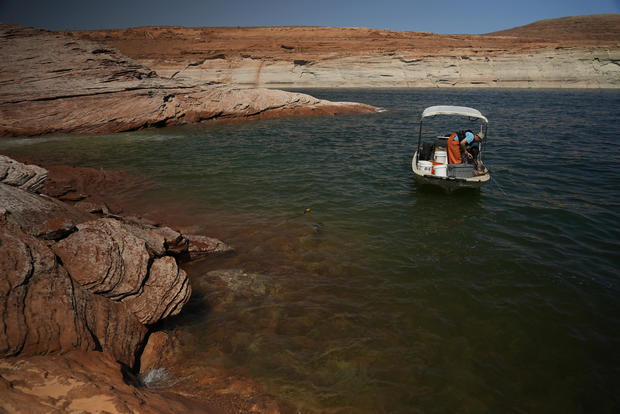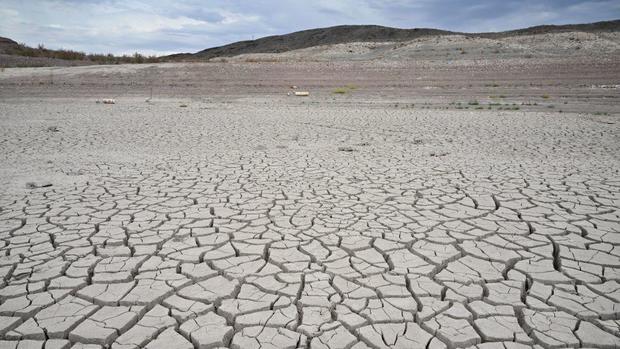Historic water shortages cause new water outages in southwest
US officialsTwo US states that depend on water from the Colorado River have endured extreme droughts, leading to more water outages. Faced, announced Tuesday.
The move, which affects Arizona and Nevada, comes at a time when officials are predicting water levels in Lake Mead, the largest reservoir in the United States, will plummet further than they actually are. The cuts will put officials in those states under tremendous pressure to plan for a hotter, drier future and population growth. Mexico will also face cuts.
Lake Mead is currently less than a quarter full, and across the seven states that depend on it, add The year that the federal government's deadline to publish proposals on plans to reduce water use was missed.
"We are taking steps to protect the 40 million people whose lives and livelihoods depend on the Colorado River.

The industry is worth $15 billion a year.Cities and farms in the region rely on official hydrological forecasts (future
And that's not all: State officials have imposed U.S. Reclamation Service-imposed water usage limits to maintain levels in river reservoirs. We are struggling to meet the deadline for at least 15% cuts, from falling further.
The combination of forecasts and cut deadlines poses unprecedented challenges for the West, leading to a drier climate. Faced with difficult decisions about how to plan for the future.
The Frontier Bureau is "very focused on getting through this into next year," but the cuts will be in place longer. There will be a need, said Kevin Wheeler, a hydrologist at the University of Oxford.
"What science is doing is maintaining these cuts until we realize that the drought is over, or is actually getting worse, and the cuts need to go deeper." It's clear that we need to," he said.
This reduction builds on a plan that seven states and Mexico signed in his 2019 to help maintain reservoir levels. Under this plan, the amount of water allocated to each state depends on the water level of Lake Mead. Mandatory cuts were made in Arizona, Nevada and Mexico in 2022 as lake levels dropped last year and the federal government declared water scarcity for the first time in the region.

Officials said hydrologists predicted further declines in the lake's water levels in Nevada, Arizona and New York next year. We anticipate additional logging in Mexico. No reductions are expected in states with high priority water rights.
Twenty-two years of drought, exacerbated by climate change and river abuse, have lowered reservoir levels for years, falling faster than experts predicted. Scorching temperatures and less snowmelt in the spring have reduced the amount of water flowing out of the Rockies before the river meanders 1,450 miles southwest and empties into the Gulf of California.
Extraordinary steps have already been taken this year to maintain the waters of Lake Powell, another large reservoir of the Colorado River that straddles the Arizona-Utah border, located upstream from Lake Mead. is taken. The lake's water flows through the Glen Canyon Dam, producing enough electricity to power 1-1.5 million homes each year.
After Lake Powell's water level reached low enough to threaten hydroelectric production, federal officials decided to secure an additional 480,000 acre feet (156 billion gallons or 592 million gallons). more than a cubic meter) of water. Dams can still produce energy. Its waters usually flow into Lake Mead.
Brad Udall, a climate scientist at Colorado State Universitywent out to Lake Powell with Bill Whitaker for the "60 Minutes" segment
"The lake is currently 155 feet below full water. It's been down about 50 feet this year," said Udall, adding that "we've taken full advantage of the system."
"We overallocated it. Now we need to figure out how to undo this," he said. "The only lever we can control on the River right now is the demand lever. We can't control supply. So we have to adjust demand." We will lose slightly more water than we did this year with a % reduction. In 2023, it will lose another 3%, for a total reduction of 21% from its original allocation.
Mexico is expected to lose 7% of her 1.5 million acre-feet it receives from the river each year. It fell about 5% last year. This water is the lifeblood of northern desert cities, including Tijuana, and large-scale agriculture in the Mexicali Valley, just south of California's Imperial Valley border.
Nevada will also lose about 8% of its water supply, but most residents will not feel the effects. Last year the state lost 7%.
Lake Mead dried up to record low levelsrevealing several sets of human bones} some now organized crime and gangs from the early days of Las Vegas, just a 30-minute drive from the lake, Buried water bodies.
- Missouri
- Mexico
- Arizona
- Nevada
- Utah
- Central America
Thank you for watching CBS NEWS.
Create a free account or
log in for more features.


